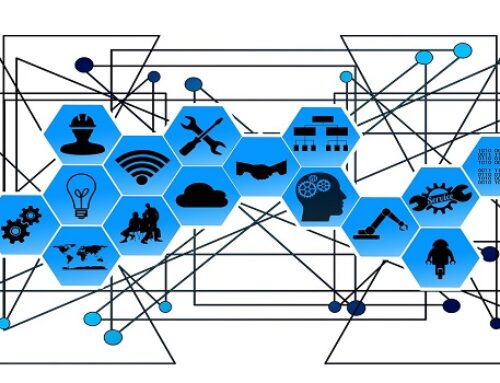Is data automation truly revolutionizing modern industry? How can companies remain competitive without digitalizing their processes? Indeed, industrial data automation today represents a crucial challenge for the digital transformation of manufacturing companies. This technological revolution enables industrial companies to collect, process, and analyze their operational data autonomously and intelligently.
In high-stakes sectors such as the digital transformation aerospace industry, data automation is a key enabler of real-time decision-making, predictive maintenance, and continuous compliance.
Through data automation, companies optimize their performance, reduce human errors, and accelerate their strategic decision-making. Consequently, understanding and implementing this approach becomes indispensable for maintaining competitive positioning. This article will guide you through the fundamental concepts, key technologies, and implementation steps to succeed in your digital transformation.

Key takeaways regarding industrial data automation:
- Clear definition: Data automation transforms the collection, processing, and analysis of industrial information
- Concrete advantages: Improved operational efficiency, cost reduction, and quality optimization
- Essential technologies: IoT, AI, machine learning, and integration platforms for successful automation
- Progressive implementation: Step-by-step approach with identification of priority use cases
- Challenges to anticipate: Team training, existing system integration, and change management
1. What is Industrial Data Automation?
Industrial data automation is a central element of current digital transformation and a major catalyst for manufacturing company evolution. It is not limited to simple process modernization; it represents a true revolution in how data is collected, processed, and utilized. A thorough understanding of its components and advantages is crucial for successful implementation and to fully exploit its potential.
1.1. How to Define Industrial Data Automation?
Industrial data automation encompasses all processes that enable autonomous collection, processing, and analysis of information. Its advantages are multiple:
- Elimination of manual interventions: It significantly reduces the need for manual engineering, thus freeing precious resources for higher value-added tasks.
- Guarantee of consistency and reliability: By automating processes, we minimize human error risks and ensure constant data quality.
- Real-time exploitation: It enables obtaining up-to-date and relevant information for rapid and informed decision-making.
In summary, industrial data automation concerns the entire data value chain, from source to utilization.
1.2. What are the Main Application Areas?
Data automation finds applications in numerous industrial sectors, optimizing operations and improving efficiency.
Here are some key examples:
- Predictive maintenance: Using real-time data to anticipate equipment failures and plan maintenance interventions proactively, thus reducing downtime and costs.
- Automated quality control: Automatic detection of production defects through data analysis, improving product quality and reducing losses.
- Optimized inventory management: Automated procurement based on actual demand, minimizing storage costs and avoiding stock shortages.
- Product traceability: Continuous monitoring of manufacturing processes to ensure compliance with standards and enable rapid problem identification when needed.
- Intelligent energy management: Energy consumption optimization by analyzing consumption data and adjusting parameters accordingly.
1.3. How is it a Pillar of Industry 4.0?
Data automation is a fundamental element of Industry 4.0. It constitutes the technological foundation for:
- Equipment interconnection: It enables connecting all industrial equipment into an intelligent ecosystem, facilitating data exchange and collaboration.
- Real-time inter-system communication: It ensures fluid and instantaneous communication between different systems, enabling efficient operations coordination.
- New technology integration: It facilitates the integration of emerging technologies such as artificial intelligence (AI), machine learning, and the Internet of Things (IoT), thus opening new perspectives for innovation.
By transforming traditional factories into connected and intelligent environments, data automation enables improved productivity, flexibility, and competitiveness.
2. What are the Benefits of Data Automation for Industrial Companies?
Data automation brings concrete and measurable benefits to manufacturing companies. These improvements directly impact operational performance, cost reduction, and overall profitability increase. It is crucial to adopt a structured approach and use key performance indicators (KPIs) to quantify these gains and demonstrate return on investment (ROI).
2.1. How Does it Improve Operational Efficiency?
Data automation significantly optimizes industrial process efficiency by eliminating repetitive manual tasks and reducing errors. Benefits include:
- Significant processing time reduction: Automation reduces information processing times by up to 70%, enabling faster production cycles and increased responsiveness to market demands.
- Human error minimization: Eliminating manual data entry reduces input errors by up to 90%, ensuring information accuracy and reliability.
- Human resource liberation: Teams are freed from manual tasks to focus on higher value-added activities, such as data analysis, innovation, and continuous improvement.
- Instantaneous synchronization: Automatic system synchronization eliminates information flow disruptions, ensuring real-time visibility across the entire value chain.
- Resource optimization: Automation enables better resource allocation and utilization, reducing waste and optimizing costs.
2.2. What Impact Does it Have on Quality and Compliance?
Data automation significantly strengthens quality and regulatory compliance standards. It enables:
- Procedure standardization: Automation standardizes control and validation procedures, ensuring process consistency and reliability.
- Complete traceability assurance: It ensures complete production process traceability, enabling rapid problem source identification and corrective measure implementation.
- Compliance report generation: Automation automatically generates regulatory compliance reports, reducing error risk and facilitating audits.
- Deviation detection: It proactively detects deviations from defined standards, enabling rapid intervention to avoid non-compliance.
- Audit facilitation: Automatic documentation facilitates audits, reducing associated time and costs.
2.3. How Does it Facilitate Decision-Making?
Data automation transforms decision-making into a data-driven process. Benefits include:
- Real-time dashboards: It provides real-time dashboards to decision-makers, giving them an overview of the situation and enabling informed decisions.
- Trend analysis: It automatically analyzes operational trends and patterns, identifying potential opportunities and threats.
- Proactive alerts: It generates proactive alerts on detected anomalies, enabling rapid intervention to avoid problems.
- Predictive analysis-based recommendations: It proposes recommendations based on predictive analysis, helping decision-makers make optimal decisions.
- Decision process acceleration: By providing relevant and up-to-date information, automation significantly accelerates the decision-making process and enables faster response to market changes.
3. What are the Key Technologies of Industrial Data Automation?
Industrial data automation relies on a sophisticated and interconnected technological ecosystem, acting in synergy to build a complete data value chain.
Each component plays a specific role in the global architecture, contributing to the efficiency and intelligence of industrial processes.

3.1. What Data Collection and Integration Tools to Use?
Data collection and integration tools constitute the foundation of data automation. They enable gathering, transforming, and consolidating information from various sources. Here are the main tools and approaches used:
- ETL (Extract, Transform, Load) platforms: These platforms automate data flows, extract data from different sources, transform it according to needs (cleaning, aggregation, etc.), and load it into a centralized storage system.
- API connectors: They facilitate integration between heterogeneous systems by enabling communication and data exchange via standardized interfaces (APIs).
- Data Lakes: Data lakes centralize structured and unstructured data storage, offering increased flexibility for analysis and discovery.
- Data Quality tools: They ensure information reliability and quality by performing data controls, validations, and corrections.
- Master Data Management (MDM) solutions: They harmonize critical data repositories, ensuring optimal consistency and quality of key information.
3.2. How Do AI and Machine Learning Intervene?
Artificial intelligence (AI) and machine learning (ML) revolutionize industrial data automation, enabling deeper analysis, more precise predictions, and continuous process optimization.
Here are some key applications:
- Machine Learning: Machine learning algorithms identify complex patterns in data, enabling predictions and more informed decisions.
- Predictive AI: Predictive AI anticipates equipment failures and optimizes maintenance, reducing downtime and costs.
- Natural Language Processing (NLP): NLP enables analyzing textual data (reports, comments, etc.) to extract relevant information.
- Computer vision: Computer vision automates visual quality inspection, enabling manufacturing defect detection with high precision.
- Production parameter optimization: Neural networks automatically optimize production parameters based on real-time data, thus improving efficiency and quality.
3.3. What Role Does IoT Play in Data Automation?
The Internet of Things (IoT) constitutes the essential sensing layer of industrial data automation. IoT sensors automatically collect real-time operational data from industrial equipment, machines, and environments.
- Real-time data collection: IoT sensors provide a continuous flow of operational data, enabling real-time monitoring and analysis.
- Industrial communication protocols: Secure industrial communication protocols (Modbus, Profinet, etc.) transmit data from sensors to processing platforms.
- IoT platforms: IoT platforms aggregate, prepare, and manage data from different IoT sources, facilitating analysis and decision-making.
- Edge Computing: Edge computing processes critical data locally near the source, reducing latency and improving responsiveness.
IoT truly constitutes the nervous system of data automation, providing the raw data necessary to fuel artificial intelligence and advanced analysis.
4. Picomto: The Solution for Digitalizing Your Industrial Procedures
Picomto revolutionizes data automation by digitalizing industrial procedures and work instructions. This innovative platform integrates perfectly into a global automation strategy, enabling the transformation of manual processes into automated and exploitable data flows.
It constitutes the essential link between data and field operations, ensuring real-time visibility and increased efficiency.
4.1. How Does Picomto Integrate into an Automation Strategy?
Picomto integrates seamlessly into the existing industrial data automation ecosystem. Here’s how:
- Automatic Data Capture: The solution automatically captures operational procedure execution data, eliminating manual entries and reducing errors.
- Native Integration: Picomto integrates natively with ERP, MES, and CMMS systems, ensuring data consistency across the entire enterprise.
- Open APIs: Its APIs facilitate connection with analysis platforms and other third-party systems, enabling personalized integration and maximum extensibility.
- Contextual Enrichment: It automatically enriches contextual data from field operations (location, time, operator…), providing a complete and exploitable overview.
Through these integrations, Picomto transforms data automation into a true operational advantage, facilitating decision-making and optimizing overall performance.
4.2. What Concrete Benefits for Your Operations?
Procedure automation with Picomto generates measurable and significant operational gains:
- Error Reduction: It reduces execution errors by 40% through guided instructions, ensuring operation quality and reliability.
- Training Acceleration: It accelerates new operator training by 60%, enabling them to become operational more quickly.
- Compliance Improvement: It improves regulatory compliance through automatic procedure standardization and action traceability.
- Traceability Optimization: It optimizes sensitive operation traceability, enabling product and service safety and quality guarantee.
- Expert Skill Transfer Facilitation: It facilitates expert skill transfer by documenting procedures and enabling knowledge sharing.
These benefits translate into increased efficiency, reduced costs, and improved customer satisfaction.
- Machine Learning: Machine learning algorithms identify complex patterns in data, enabling predictions and more informed decisions.
- Predictive AI: Predictive AI anticipates equipment failures and optimizes maintenance, reducing downtime and costs.
- Natural Language Processing (NLP): NLP enables analyzing textual data (reports, comments, etc.) to extract relevant information.
- Computer vision: Computer vision automates visual quality inspection, enabling manufacturing defect detection with high precision.
- Production parameter optimization: Neural networks automatically optimize production parameters based on real-time data, thus improving efficiency and quality.
Conclusion
Industrial data automation represents an unavoidable lever of modern competitiveness. Indeed, this digital transformation optimizes operational efficiency, improves quality, and accelerates decision-making.
Furthermore, technologies like IoT, AI, and integration platforms facilitate this revolution. However, successful implementation requires a methodical and progressive approach.
Moreover, Picomto perfectly complements this approach by digitalizing operational procedures. Finally, acting now becomes crucial to maintain competitive advantage. Data automation is no longer an option but a strategic necessity.
FAQ
What is the objective of industrial system automation?
To optimize productivity, reduce costs, and improve manufacturing process quality.
What is database automation?
Automated management of critical information, system synchronization, and real-time report generation.
What is industrial automation?
Integration of advanced technologies to automatically control and optimize production processes.
What are the advantages of industrial automation?
Increased productivity, consistent quality, reduced costs, enhanced safety, and improved competitiveness.






Leave A Comment